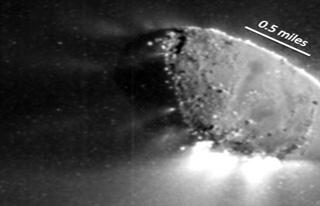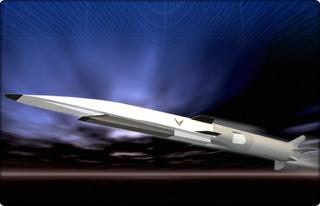
This enhanced image, taken by EPOXI's Medium-Resolution Instrument, is one of the closest taken of comet Hartley 2 by NASA's EPOXI mission. It shows jets and where they originate from the surface. Photo by: NASA/JPL-Caltech/UMD.
WASHINGTON (BNS): Experts at University of Maryland-led EPOXI mission found that Comet Hartley 2 uses dry ice as a 'jet fuel'.
Images from the flyby show spectacular jets of gas and particles bursting from many distinct spots on the surface of the comet. This is the first time images of a comet have been sharp enough to allow scientists to link jets of dust and gas with specific surface features. Analysis of the spectral signatures of the materials coming from the jets shows primarily CO2 gas (carbon dioxide) and particles of dust and ice.
“Previously it was thought that water vapour from water ice was the propulsive force behind jets of material coming off of the body, or nucleus, of comet,” said University of Maryland astronomy professor Jessica Sunshine, who is deputy principal investigator for the EPOXI mission, according to a news release by the University of Maryland.
“We now have unambiguous evidence that solar heating of subsurface frozen carbon dioxide (dry ice), directly to a gas, a process known as sublimation, is powering the many jets of material coming from the comet. This is a finding that only could have been made by travelling to a comet, because ground based telescopes can’t detect CO2 and current space telescopes aren’t tuned to look for this gas,” Ms. Sunshine added.
The scientists have also found that water and carbon dioxide dominate the infrared spectrum of Comet Hartley 2’s environment and that organics, including methanol, are present at lower levels.
What is surprising is that there is a lot more carbon dioxide escaping this comet than expected.
“The distribution of carbon dioxide and dust around the nucleus is much different than the water distribution, and that tells us that the carbon dioxide rather than water takes dust grains with it into the coma as it leaves the nucleus, said Assistant Research Scientist Lori Feaga. “The dry ice that is producing the CO2 jets on this comet has probably been frozen inside it since the formation of the solar system,” the researcher added.
Mission Principal Investigator and science team leader Michael A’Hearn, a University of Maryland professor of astronomy, said the mission has provided, and continues to provide, a tremendous wealth of data about Hartley 2 and the team expects to announce more science findings in the coming weeks.
The Deep Impact spacecraft that flew past comet Hartley 2 has three instruments -- two telescopes with digital color cameras and an infrared spectrometer. The spectrometer measures the absorption, emission and reflection of light (spectroscopic signature) that is unique to each molecular compound. This allows Maryland scientists to determine the composition of the material on the comet's surface, in the jets, and in the coma, or cloud of particles around it.
The spacecraft's images show that Hartley 2 has an elongated nucleus, 2 kilometers in length and 0.4 kilometers wide at the narrow neck. Hartley 2 is only the 5th cometary nucleus ever seen and exhibits similarities and differences to the bodies or nuclei of other comets.
 Previous Article
Previous Article Next Article
Next Article













The Indian Air Force, in its flight trials evaluation report submitted before the Defence Ministry l..
view articleAn insight into the Medium Multi-Role Combat Aircraft competition...
view articleSky enthusiasts can now spot the International Space Station (ISS) commanded by Indian-American astr..
view article